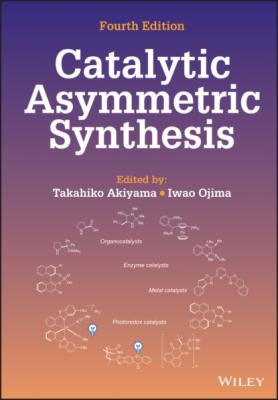Catalytic Asymmetric Synthesis. Группа авторов
Чтение книги онлайн.
Читать онлайн книгу Catalytic Asymmetric Synthesis - Группа авторов страница 35
 silyl ether (see above; Eq. 1.22) [47]. When ethyl 4‐oxo‐2‐pentenoate was employed as a nucleophile, a domino Michael/Michael reaction proceeded to afford a trisubstituted cyclopentanone in nearly enantiomerically pure form (Eq. 1.36). By using this reaction as a key step, a one‐pot, 152‐minute total synthesis of Corey lactone was realized [64]. Latanoprost [64b] and clinprost [65] were also synthesized by using the same key reaction.
silyl ether (see above; Eq. 1.22) [47]. When ethyl 4‐oxo‐2‐pentenoate was employed as a nucleophile, a domino Michael/Michael reaction proceeded to afford a trisubstituted cyclopentanone in nearly enantiomerically pure form (Eq. 1.36). By using this reaction as a key step, a one‐pot, 152‐minute total synthesis of Corey lactone was realized [64]. Latanoprost [64b] and clinprost [65] were also synthesized by using the same key reaction.
1.7. COMBINATION OF TWO CATALYSTS
In the previous sections, asymmetric reactions using a single chiral organocatalyst were described. By the use of two catalysts, synergistic effects would be expected [66]. A combination of organocatalyst with another catalyst can be used to realize asymmetric reactions, which are difficult to achieve by using a single catalyst. Some of the successful reactions will be discussed in this section.
1.7.1. Combination of Two Organocatalysts
Rovis reported a domino Michael/benzoin reaction of 1,3‐diketones and α,β‐unsaturated aldehydes by using a combination of diarylprolinol silyl ether and N‐heterocyclic carbene catalyst (Eq. 1.37) [67]. This is a formal [3+2] cycloaddition reaction that affords highly functionalized cyclopentanone derivatives with excellent enantioselectivity. When only diarylprolinol silyl ether was employed as a single catalyst, first Michael reaction proceeded to afford the Michael product with lower enantioselectivity, because of the retro‐Michael reaction. A combined use of the two catalysts not only provided the formal [3+2] cycloaddition products but also realized excellent enantioselectivity.
Luo reported a unique two‐catalyst cooperative system of a chiral primary amine and a ketone for the asymmetric α‐hydroxylation of β‐ketocarbonyls with H2O2 (Eq. 1.38) [68]. A chiral primary amine not only reacts with β‐ketocarbonyl to generate an enamine, it also reacts with 2,2,2‐trifluoroacetophenone to generate a chiral ketimine, which reacts further with H2O2 to afford an oxaziridine intermediate. The chiral enamine–chiral oxaziridine coupling provided α‐hydroxylated β‐ketocarbonyls in excellent yield with excellent enantioselectivity.
1.7.2. Combination of Organocatalyst and Metal Catalyst
Metal catalysts are widely used in organic synthesis, and a combination of metal catalyst with enamine and iminium ion intermediates opens a new avenue for the synthetic organic chemistry [69]. However, there are limitations to the use of organocatalysts and metal catalysts cooperatively. In organocatalytic reactions involving an enamine as an intermediate, water would be generated in the reaction, and organometallic catalysts have to act efficiently under these reaction conditions. Moreover, the organocatalyst is usually an amine, and metal catalysts also have to catalyze the reaction in the presence of organo amine catalyst. In spite of these limitations, several successful reactions have been developed using a combination of organocatalyst and metal catalyst.
1.7.2.1. Enamine and Metal Catalyst
MacMillan reported α‐trifluoromethylation (Eq. 1.39) [70], α‐arylation (Eq. 1.40) [71], and α‐vinylation [72] of aldehydes with iodonium salts catalyzed by a combined use of MacMillan’s catalyst and copper catalyst. In the α‐trifluoromethylation reaction, Togni’s reagent is employed as CF3 source. In the α‐arylation reaction, Cu(I) reacts with diaryliodonium salts to generate aryl‐Cu(III) species, which react with an enamine to generate η1 iminium organocopper species. Reductive elimination afforded an α‐arylated product, and excellent enantioselectivity was obtained.
Cordova reported an α‐allylation of an aldehyde with an allyl acetate catalyzed by a combination of diphenylprolinol silyl ether and Pd catalyst (Eq. 1.41). A π‐allyl complex would be generated from allyl acetate and Pd(PPh3)4, which reacts with a chiral enamine generated from an aldehyde and organocatalyst [73]. Excellent enantioselectivity was obtained.
Cozzi reported an asymmetric allylation reaction of an aldehyde and an allyl alcohol catalyzed by a combination of MacMillan’s catalyst and a Lewis acid such as InBr3 (Eq. 1.42) [74]. This is an SN1‐type reaction, and the chiral enamine, which is generated from an aldehyde and MacMillan’s catalyst, reacts with an allylic carbenium ion, which is generated from an allyl alcohol and InBr3 to afford the product after hydrolysis.
Dixon reported an asymmetric carbocyclization of aldehyde‐linked allene by a combined use of diarylprolinol silyl ether and Pd(OAc)2 to afford a substituted cyclopentanecarbaldehyde with good enantioselectivity (Eq. 1.43) [75]. The organocatalyst reacts with an aldehyde to generate a chiral enamine, which reacts with allene activated by Pd(II).
Gong reported that diphenylprolinol/Pd(II) cooperative catalysis has enabled a highly enantioselective addition of cyclic ketones to unactivated alkenes (Eq. 1.44) [76]. The reaction includes amide‐directed, regioselective activation of alkenes by Pd(II) and enhancing the nucleophilicity of α‐carbon of the ketones by enamine catalysis, which provides the γ‐addition products with good to high yields and efficient stereochemical control.